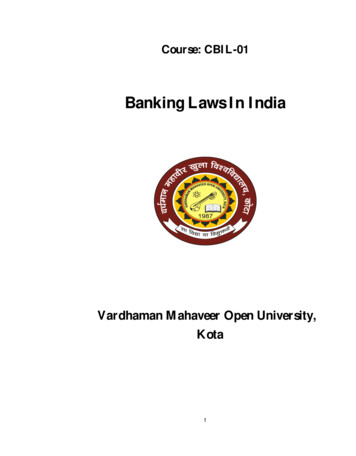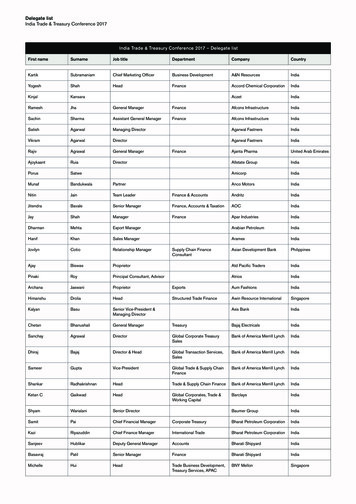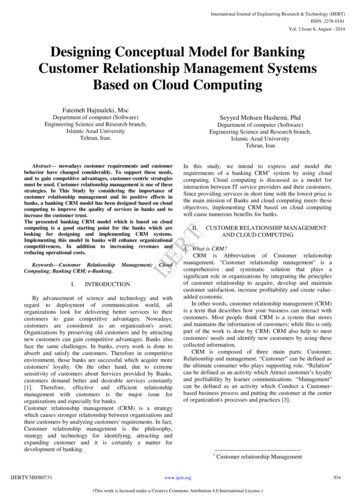
Transcription
Course: CBIL-01Banking Laws In IndiaVardhaman Mahaveer Open University,Kota1
Course: CBIL-01Banking Laws In IndiaVardhaman Mahaveer Open University,Kota2
Course Development CommitteeChairmanProf. L. R. GurjarDirector (Academic)Vardhaman Mahaveer Open University, KotaConvener and MembersConvenerDr. Yogesh Sharma, Asso. ProfessorDepartment of LawVardhaman Mahaveer Open University, KotaExternal Members:1. Prof. Satish C. ShastriDean, Faculty of law, MITS, LaxmangarhSikar, and Ex. Dean,University of Rajasthan, Jaipur (Raj.)3. Dr. M.L. PitaliyaEx. Dean, MDS University, AjmerPrincipal, Govt. P.G.College, Chittorgarh (Raj.)CBIL-01Prof. H.B. NanadwanaDirector, SOCEVardhaman Mahaveer Open University, Kota2.Prof. V.K. SharmaDeptt.of LawJ.N.Vyas University, Jodhpur4.Prof. (Dr.) Shefali YadavProfessor & Dean - LawDr. Shakuntala Misra NationalRehabilitation University, Lucknow5. Dr Yogendra Srivastava, Asso. Prof.School of Law, Jagran Lakecity University, BhopalEditing and Course WritingEditor:Course Writer:Dr. Yogesh SharmaDr Visvas ChauhanConvener, Department of LawState P. G. Law College, BhopalVardhaman Mahaveer Open niversity, KotaAcademic and Administrative ManagementProf. Vinay Kumar PathakProf. L.R. GurjarVice-ChancellorDirector (Academic)Vardhaman Mahaveer Open University, KotaVardhaman Mahaveer Open University, KotaProf. Karan SinghDr. Anil Kumar JainDirector (MP&D)Additional Director (MP&D)Vardhaman Mahaveer Open University, KotaVardhaman Mahaveer Open University, KotaCourse Material ProductionProf. Karan SinghDirector (MP&D)Vardhaman Mahaveer Open University, KotaProduction 2015 ISBNAll right reserved no part of this book may be reproduced in any form by mimeograph or any other means,without permission in writing from the V.M. Open University, Kota. Printed and published on behalf of V.M.Open University, Kota by Director (Academic)Printed by 3
Vardhaman Mahaveer Open University, KotaBanking Laws in IndiaUnit No.Unit NamePage No.Unit – 1History of Banking Law7Unit – 2The RBI Act, 1934-I35Unit – 3The RBI Act, 1934-II62Unit – 4The Indian Banking System98Unit – 5The Banking Regulation Act-I121Unit – 6The Banking Regulation Act-II146Unit – 7Negotiable Instrument Act, 1881-I172Unit – 8Negotiable Instrument Act, 1881-II205Unit – 9Banking Ombudsman226Unit – 10Bank Frauds253Unit – 11Development Banks281Unit – 12Debt Recovery Tribunal311Unit – 13The SARFAESI Act, 2002334-3574
CBI-1IntroductionThis Course is conceived and produced for the students of Certificate Program inBanking and Insurance Laws who need to study the different basic aspects ofBanking Laws. It will provide understanding, skill and elementary knowledge ofBanking Laws. It will train learner for career as Banking Officer, Agents orprofessionals. Course will also inculcate the understanding of Banking Laws at stateand national level and it will provide some other regulatory dimensions in BankingLaws field.This Block contains Thirteen Units. First Unit will introduce students with themeaning of Bank and Banking, its historical development and laws in India beforeindependence and after independence along with the nature of banking also. ThisSecond unit deals with the Reserve Bank of India Act, 1934. It informs about theEstablishment and incorporation of Reserve Bank in India along with the businesswhich the Bank may transact and the business which the Bank may not transact. TheThird Unit again deals with the Reserve Bank of India Act, 1934 which informs aboutthe functions of Central Bank. It also informs students about the Provisions Relatingto Non-Banking Institutions receiving deposit and Financial Institutions and thePower of Bank to determine policy and issue directions to other banks in India.Unit Four will introduce students with the Indian Banking System and theNationalization of the various Banks. It apprises students with History of BankingRegulation Act, 1949 along with Present Banking Structure and its related issues.Unit Five also helps in knowing the provisions of Banking Regulation Act, 1949which informs about the Forms of business in which banking companies may engageand Power of Reserve Bank to control advances by banking companies. Unit Six willexplain students about the other provisions of Banking Regulation Act, 1949. Itapprises about Production of documents of confidential nature and Power of theReserve Bank to give Directions. It also informs about Suspension of Business andwinding up of the Banking Companies along with Court Liquidator and Reserve Bankto be Liquidator and the Powers of High Court in winding up etc.Unit seventh will introduce students with The Negotiable Instruments Act, 1881. Itinforms about the Negotiable Instruments, Promissory Note and Hundies etc. Howthe Payments of these are made? Unit Eight explains who is Holder and what are hisRights and Duties? It also explains about the Stop Payment and Payment of PostDated Cheques along with the liabilities of Drawer and Drawee.5
Unit Nine will explain students about the meaning, need and importance of BankingOmbudsman. It will help you in recognizing the role of Banking Ombudsman inprotection and promoting of Banking. Unit Ten deals with Bank Frauds its kinds andhow they shall be reported and How Police and CBI shall deal with them. Unit Elevenwill explain students about the meaning, need and importance of DevelopmentBanking in India. It gives account various development Banks of India. Provisions ofthe National Housing Bank established under the National Housing Act, 1987 hasbeen explained separately. Unit Twelve deals with importance and concept of debtrecovery tribunal established under Debt Recovery Tribunal Act, 1993. It explains theModes of Recovery of Debts. It also explains the Powers and functions of theRegistrar for that. Unit Thirteen deals with The Securitization and Reconstruction ofFinancial Assets and Enforcement of Security Interest Act, 2002 with Registration ofsecuritization companies or reconstruction companies along with Power of ReserveBank to determine policy and issue directions in this regards.6
Unit-1 History of Banking LawsObjectives:After going through this unit you should be able to understand: the development of the banking systemthe development of banking lawsthe present banking systemStructure:1.1. Introduction1.2. Origin of ‘banking’1.3. Evolution of Legislative Regulation of Banking in India1.4. Banking Structure and relevant Theories1.5 Small Financial Institutions1.6. Indian Experience with Small Banks- A Journey Banking Models1.7. Structure of Universal Banking Model1.8. Global Development on structural reform1.9. Competition and Licensing of Banks in India1.10. Legal Framework for Banking1.11. Summary1.12. Some Useful Books1.13. Check Your Progress1.14. Answer to Check Your Progress1.15. Terminal Questions1.1. Introduction:Institutional Evolution of the Indian Banking: The indigenous system of bankinghad existed in India for many centuries, and catered to the credit needs of theeconomy of that time. The famous Kautilya Arthashastra, which is ascribed to be7
dating back to the 4th century BC, contains references to creditors and lending.For instance, it says “If anyone became bankrupt, debts owed to the state hadpriority over other creditors”. Similarly, there is also a reference to “Interest oncommodities loaned” (PRAYOG PRATYADANAM) to be accounted as revenueof the state. Thus, it appears that lending activities were not entirely unknown inthe medieval India and the concepts such as ‘priority of claims of creditors’ and‘commodity lending’ were established business practices.During the period of modern history, however, the roots of commercial banking inIndia can be traced back to the early eighteenth century when the Bank of Calcuttawas established in June 1806 –which was renamed as Bank of Bengal in January1809 – mainly to fund General Wellesley’s wars. This was followed by theestablishment of the Bank of Madras in July 1843, as a joint stock company,through the reorganization and amalgamation of four banks viz., Madras Bank,Carnatic Bank, Bank of Madras and the Asiatic Bank. This bank brought aboutmajor innovations in banking such as use of joint stock system, conferring oflimited liability on shareholders, acceptance of deposits from the general public,etc. The Bank of Bombay, the last bank to be set up under the British Raj pursuantto the Charter of the then British East India Company, was established in 1868,about a decade after the India’s first war of independence.The three Presidency Banks, as these were then known, were amalgamated inJanuary 1921 to form the Imperial Bank of India, which acquired the three-foldrole: of a commercial bank, of a banker’s bank and of a banker to the government.It is interesting to note here that merger of banks and consolidation in the bankingsystem in India, is not as recent a phenomenon as is often thought to be, and datesback to at least 1843 – and the process, of course, still continues. With theformation of the Reserve Bank of India in 1935, some of the central bankingfunctions of the Imperial Bank were taken over by the RBI and subsequently theState Bank of India, set up in July 1955, assumed the other functions of theImperial Bank and became the successor to the Imperial Bank of India.11The Special Address delivered by Shri V Leeladhar, Deputy Governor, ReserveBank of India at the Bankers’ Conference (BANCON) 2007 on November 26, 2007at Hotel Taj Lands End, Mumbai.8
1.2. Origin of the ‘Banking’:Origin of ‘Banking’ the first bank was probably the religious temples of theancient world wherein gold was stored in the form of easy-to-carry compressedplates. Their owners justly felt that temples were the safest places to store theirgold as they were constantly attended, well built and were sacred, thus deterringwould-be thieves. There are extent records of loans from the 18th century BC inBabylon that were made by temple priests to merchants. Ancient Greece holdsfurther evidence of banking. Greek temples as well as private and civic entitiesconducted financial transactions such as loans, deposits, currency exchange, andvalidation of coinage. There is evidence too of credit, whereby in return for apayment from a client, a moneylender in one Greek port would write a credit notefor the client who could “cash” the note in another city, saving the client thedanger of carting coinage with him on his journey. Ancient Rome perfected theadministrative aspect of banking and saw greater regulation of financialinstitutions and financial practices. Charging interest on loans and paying intereston deposits became more highly developed and competitive.The origin of banking in India can be traced back to almost the Vedic period. Thetransformation from pure money lending to proper banking appears to have takenplace before the times of Manu. Manu, a great Hindu jurist, had devoted a sectionof his work explaining the deposits and advances and he even laid down certainrules on rates of interest. Throughout Mauryan period and later on Desi bankersplayed some role in the economy of the country. However, it was during theMogul period that indigenous bankers started playing a vital role in lendingmoney and financing of the foreign trade and commerce. Banking during Britishperiod before independence. The first joint stock bank, namely The General Bankof India was established in 1786. Later on Bank of Hindustan and Bengal Bankcame into existence. Bank of Hindustan carried on business till 1906. East IndiaCompany established the following three banks, namely The Bank of Bengal in1809, The Bank of Bombay in 1840, and Bank of Madras in 1843. They werecollectively called Presidency Banks and were well functioning independent units.The three banks established by the East India Company were amalgamated in1920 and a new bank called Imperial Bank of India was established. A number of9
private banks had been established by the businessmen from mid of the 19thcentury onwards.In the surcharged atmosphere of Swadeshi movement, a number of banks withIndian management, namely, Punjab National Bank Ltd., Bank of India Ltd.,Canara Bank Ltd, Indian Bank Ltd. etc. were established. The Reserve Bank ofIndia was established as the Central bank of the country in 1935 under an actcalled Reserve bank of India Act. Later on with the passage of the BankingRegulation Act passed in 1949, RBI was brought under government control.Under this Act, RBI was conferred with supervision and control of the banks andlicensing powers and the authority to conduct inspections was also given to it.After independence, in 1955, the Imperial Bank of India was nationalized and wasgiven the name “State Bank of India”. It was established under State Bank ofIndia Act, 1955. In 1960, RBI was empowered to force the compulsory merger ofthe weak banks with the strong ones. This led to reduction in the number of banksfrom 566 in 1951 to about 89 in 1969. On July 19, 1969, 14 major banks werenationalized. In1980, another six banks were nationalized, and thus raising thenumber of nationalized banks to 20. On the suggestions of NarsimhamCommittee, the Banking Regulation Act was amended in 1993 and thus the gatesfor the new private sector banks were opened. Normally chartered accountingfirms audit trading and manufacturing firms. The work of bank branch audit is avery specialized job and comes once in a year. Number of CA firms eligible forBank audits are limited. Auditors should update their knowledge about RBIcirculars as RBI on monthly /yearly basis keep on revising its guidelines. Audit inthis field should be done with extra precaution.21.3. Evolution of Legislative Regulation of Banking in India:In the very early phase of commercial banking in India, the regulatory frameworkwas somewhat diffused and the Presidency Banks were regulated and governed bytheir Royal Charter, the East India Company and the Government of India of thattime. Though the Company law was introduced in India way back in 1850, it didnot apply to the banking companies. The banking crisis of 1913, however, n-ofbanking10
revealed several weaknesses in the Indian banking system, such as the lowproportion of liquid assets of the banks and connected lending practices, resultingin large-scale bank failures. The recommendations of the Indian Central BankingEnquiry Committee (1929-31), which looked into the issue of bank failures, pavedthe way for legislation for banking regulation in the country.Though the RBI, as part of its monetary management mandate, had, from the verybeginning, been vested with the powers, under the RBI Act, 1934, to regulate thevolume and cost of bank credit in the economy through the instruments of generalcredit control, it was not until 1949 that a comprehensive enactment, applicableonly to the banking sector, came into existence. Prior to 1949, the bankingcompanies, in common with other companies, were governed by the IndianCompanies Act, 1913, which itself was a comprehensive re-enactment of theearlier company law of 1850. This Act, however, contained a few provisionsspecially applicable to banks. There were also a few ad hoc enactments, such astheBanking Companies (Inspection) Ordinance, 1946 and the Banking Companies(Restriction of Branches) Act, 1946, covering specific regulatory aspects. In thisbackdrop, in March 1949, a special legislation, called the Banking CompaniesAct, 1949, applicable exclusively to the banking companies, was passed; this Actwas renamed as the Banking Regulation Act from March 1966. The Act vested inthe Reserve Bank the responsibility relating to licensing of banks, branchexpansion, and liquidity of their assets, management and methods of working,amalgamation, reconstruction and liquidation. Important changes in severalprovisions of the Act were made from time to time, designed to enlarge or amplifythe responsibilities of the RBI or to impart flexibility to the relative provisions,commensurate with the imperatives of the banking sector developments.It is interesting to note that till March 1966, the Reserve Bank had practically norole in relation to the functioning of the urban co-operative banks. However, bythe enactment of the Banking Laws (Application to Co-operative Societies) Act,1965, certain provisions of the Banking Regulation Act, regarding the mattersrelating to banking business, were extended to the urban co-operative banks also.11
Thus, for the first time in 1966, the urban co-operative banks too came within theregulatory purview of the RBI.Prudential Policy Framework for Banking Regulation and Supervision The basicrationale for exercising fairly close regulation and supervision of bankinginstitutions, all over the world, is premised on the fact that the banks are “special”– for several reasons. The banks accept uncollateralized public deposits, are partof the payment and settlement system, enjoy the safety net of deposit insurancefunded by the public money, and are an important channel for monetary policytransmission. Thus, the banks become a keystone in the edifice of financialstability of the system – which is a ‘public good’ that the public authorities arecommitted to provide. Preventing the spread of contagion through the bankingsystem, therefore, becomes an obvious corollary of regulating the banks to preempt any systemic crisis, which can entail enormous costs for the economy as awhole. This is particularly so on account of the inevitable linkages that the bankshave by virtue of the nature of their role in the financial system. Ensuring safetyand soundness of the banking system, therefore, becomes a predominant objectiveof the financial regulators. While the modalities of exercising regulation andsupervision over banks have evolved over the decades, in tandem with the marketand technological developments, the fundamental objective underlying theexercise has hardly changed. Of course, a well-regulated and efficient bankingsector also enhances the allocative efficiency of the financial system, therebyfacilitating economic growth.In this backdrop, as the functions of the RBI evolved over the years, the focus ofits role as a regulator and supervisor of the banking system has shifted graduallyfrom micro regulation to macro prudential supervision. A journey through themajor landmarks in the evolution of the RBI’s role vis-à-vis the commercial banksprovide interesting insights. Allow me to very briefly dwell on the salient aspectsof this evolutionary process.As regard the prudential regulatory framework for the banking system, we havecome a long way from the administered interest rate regime to deregulated interestrates, from the system of Health Codes for an eight-fold judgmental loanclassification to the prudential asset classification based on objective criteria, from12
the concept of simple statutory minimum capital and capital-deposit ratio to therisk-sensitive capital adequacy norms – initially under Basel I framework and nowunder the Basel II regime. There is much greater focus now on improving thecorporate governance set up through “fit and proper” criteria, on encouragingintegrated risk management systems in the banks and on promoting marketdiscipline through more transparent disclosure standards. The policy endeavor hasall along been to benchmark our regulatory norms with the international bestpractices, of course, keeping in view the domestic imperatives and the countrycontext. The consultative approach of the RBI in formulating the prudentialregulations has been the hallmark of the current regulatory regime which enablestaking account of a wide diversity of views on the issues at hand.On the supervisory side, RBI has traversed vast territory in progressively refiningour supervisory focus to ensure a safe and sound banking system, comparablewith the best in the world. Thus, continually graduated from the system of on-siteAnnual Appraisal of the banks by the RBI followed in the 1970s to the system ofAnnual Financial Review during the 1980s, then on to the Annual FinancialInspection of stand-alone banks during the 1990s and further on to theconsolidated supervision of financial conglomerates so as to address thesupervisory concerns on a group-wide basis. The off-site monitoring of thebanking system was also introduced in 1995 as a part of the supervisory strategyof ongoing supervision of the banks, so as to supplement the periodical full-scopeon-site bank examinations. The supervisory ratings models (CAMELS andCACS), based on crucial prudential parameters, and were also developed by theRBI to provide a summary view of the overall health of the banks. The PromptCorrective Action (PCA) Framework was put in place to enable timelyintervention in case of any incipient stress in a bank. The latest supervisoryinitiative has been the introduction of risk-based supervision of the banks so as tomove away from transaction audit and to enable the modulation of the supervisoryefforts in tune with the risk profile of the banks and to achieve optimaldeployment of the scarce supervisory resources. Last but not the least, the Boardfor Financial Supervision, constituted in 1994 under the Chairmanship of theGovernor, RBI has been the guiding force in securing the transformation in theregulatory and supervisory apparatus of the banking system. While the multi13
dimensional regulatory and supervisory measures are justifiably reflected in thesignificantly improved prudential parameters of the Indian banking system, be itthe level of NPAs or the capital adequacy ratios, there is hardly any room forcomplacence. In the era of ever-increasing financial globalization and in the faceof rapid financial innovations, all of us will continually need to remain on a steeplearning curve and upgrade our skills and knowledge to be able to meet theemerging challenges in the financial world.Some Elucidation Regarding the Regulatory Environment: The Reserve Bank ofIndia has earned, in the service of our country, a proven track record ofprofessionalism, which has lent it considerable credibility – both domestically andglobally. This credibility enables the RBI to confidently carry on with the reformprocess to be able to maintain price and financial stability, while enabling a selfaccelerating equitable growth at elevated levels1.4. Banking Structure and Relevant Theories:A number of studies have sought to examine whether the nature of the financialstructure matters for the economic growth of a country. While some studies havesuggested that financial structure did not matter for economic growth, the othersstudies establish that the structure of the financial system can matter for growth.In this debate, Rajan and Zingales (1998) observed that rather than the nature offinancial structure, it is the financial system’s overall level of development thatmatters for growth. Empirical research on the comparative merits of ‘bank-based’and ‘market-based’ financial systems has centered on Germany and Japan as‘bank-based systems’ and the United States and the United Kingdom as ‘marketbased systems’. Despite their differences various models exhibit similarities.(www.rbi.org.in)Appropriate Banking System: Jaffe and Levonian (2001) argue that the demandfor banking services varies across economies and is dependent on economic,demographic and geographic features of each country. Available literaturehighlights a few strands of thinking, which are relevant to the debate on what is anappropriate or optimal banking structure for an economy. Strand 1 Theinstitutional theory, as discussed by DiMaggio and Powell (1983), which14
examines the factors that influence organizations to change their performance andthe responses as per the demands made on them. Strand 2 The work of Lin, Sunand Jiang (2009) mentions about the ‘factor endowment’ in an economy at eachstage of its development, which determines the optimal industrial structure in thereal sector. This in turn constitutes the main determinant of the size distributionand risk features of viable enterprises with implications for the appropriateinstitutional arrangement of financial services at that stage. Strand 3 According toReid (2010), some financial structures may be better suited to growth at certainstages of development but they may be less well suited in other circumstances.The above thinking points out to the fact that developments in the macroeconomicenvironment and structural changes in the economy are crucial variables that maydecide the banking structure and the changes in it required from time to time.Drawing on the above thinking and the relevant literature one can visualize thatchanges in banking structures are influenced mainly by developments in themacro-level environment in which banks function. As the real economy evolvesand structural changes take place, the need for large quantum and type of financeand services required by various entities also varies. It is very hard to say withcertainty if there is an optimal size and if there is, what it might be. If onedefinition of the optimal size is that all borrowers and lenders find access tofinancial intermediation on their preferred conditions, then there may never be anoptimal size, as this will always be changing and there will always be leads andlags involved in the adjustment process. Perhaps a more fruitful approach is tothink instead about the degree to which the financial system is suited to thecurrent needs of the real economy. In sum, an appropriate or optimal bankingstructure is one, which evolves in such a way that it accommodates the changingrequirements of various constituents of the economy.The broad functions and objectives of the banking structure can be similar acrosscountries. But, globally, one can see different models of banking structures,different ownership patterns, and different emphasis on size of the banks.Country‐level studies show that small, regional and local banks may perform verydifferently from large banks. Greater access to local information, greatercommitment to local prosperity, differences in costs and risk management, and15
competition policy could explain the specific influence of such type of banks onlocal economic development. In developing countries where economicdevelopment is hampered by insufficient and inadequate access to financialservices in rural areas, local banks could improve financing opportunities to smalland medium size enterprises and encourage entrepreneurship. Economies atdifferent stages of development require different blends of financial services tooperate effectively. Depending upon the structure and needs of an economy, thecountry’s banking system should be dynamic and competitive to cater to thediverse needs of the economy.1.5. Small Financial InstitutionsThere has been a long standing debate on whether large banks with their financialstrength and resources and ability for greater reach are better vehicles for financialinclusion than the small banks with limitations in these aspects but having ‘localfeel’ and cultural synergy with the local population. In other words, whether weneed small number of large banks or large number of small banks to promotefinancial inclusion? It is undeniable that small banks play a very important role inthe supply of credit to small business units, small farmers and other unorganizedsector entities. The need and the relevance of small banks have been debated inIndia from time to time and accordingly, various initiatives were put in place topromote small banks geared towards small borrowers. As on March 31, 2013,there were 64 RRBs (consolidated from 196 RRBs originally set up), 1,606 urbanco-operative banks (UCBs), 31 State co-operative banks (StCBs), 371 districtcentral co-operative banks (DCCBs), 20 State Cooperative Agriculture and Ruraldevelopment Banks (SCARDBs) and 697 Primary Cooperative Agriculture andRural development Banks (PCARDBs).Cross-country experience:- The United States has got a banking structurecomprising both big banking institutions, hand in hand, with small communitybanks focusing on specific geographical areas. Small community banks form avery important segment of the US banking system, though they account for a very16
small share of the total banking assets of the country. These banks are closely tiedto the local communities and focus on mainly ‘relationship banking’.In the US, there are about 7,000 small community banks with asset size rangingfrom less than US 10 million to US 10 billion or more. They account for about46 per cent of all small loans to businesses and farms and in terms of the number,they constitute about 92 per cent of the all the FDIC insured institutions (FDIC,2013).Enactment of the Mutual Banks Act of 1993 in South Africa was an attempt toadd depth to the financial system by creating a banking category that had lessstringent capital adequacy prerequisites but similar risk managementrequirements. In an attempt to ensure effective financial inclusion following theperceived failure of the commercial banks and the state-owned developmentbanks in Nigeria, over 1,400 community banks were set up in both rural and urbanareas.In Indonesia, the banking system is multifarious, with simultaneous existence ofcommercial banks in big cities, branches of provincial banks in small towns, theUnit Desa (village banks) of Bank Rakyat Indonesia (BRI), the local small banks,cooperative banks and private rural banks.The pros and cons of encouraging small banks as preferred vehicles for financialinclusion are as under:Pros:i.Small banks have a small capital base and therefore lend to smallborrowers.ii.Banks with limited area of operation would require less infrastructure andstaff and, hence, the operational expenses would be low.iii.Small banks would help improve penetration of banking sector tounbanked areas and mobilize resources.iv.Such banks are expe
1.12. Some Useful Books 1.13. Check Your Progress 1.14. Answer to Check Your Progress 1.15. Terminal Questions 1.1. Introduction: Institutional Evolution of the Indian Banking: The indigenous system of banking had existed in India for many centuries, and










